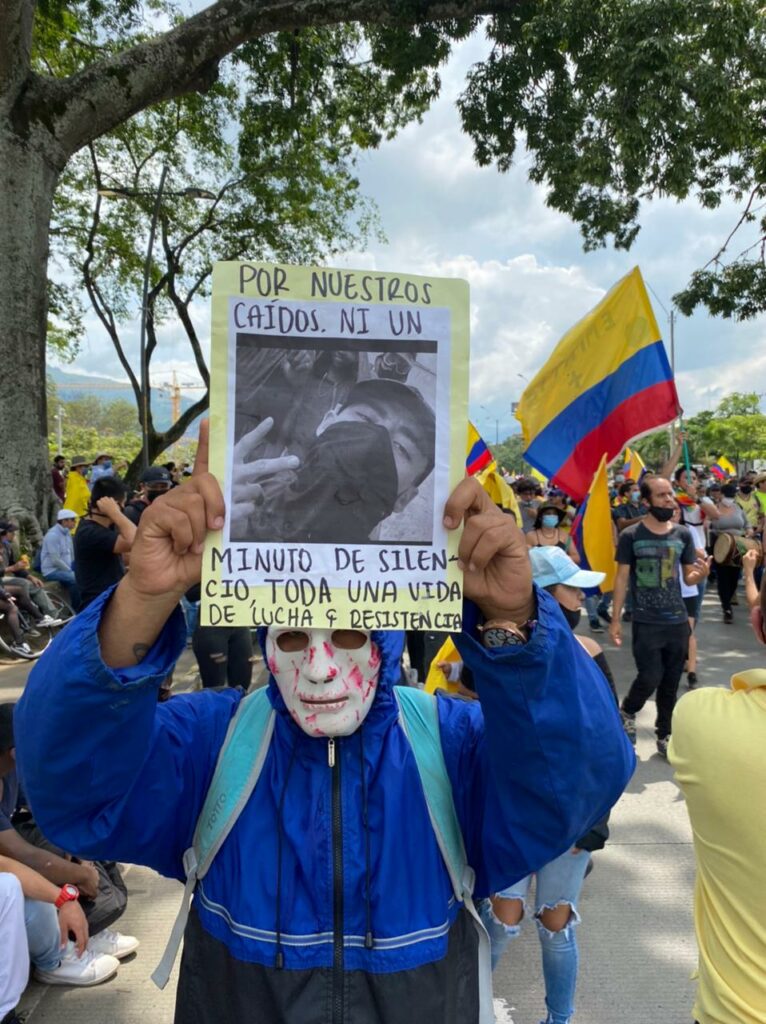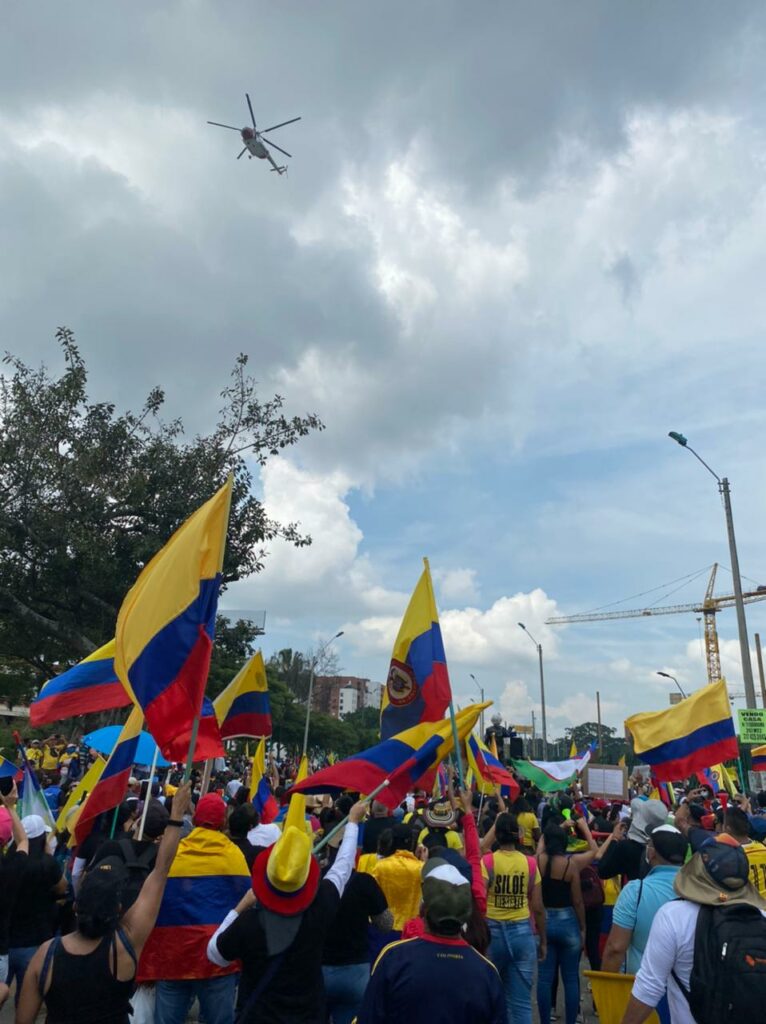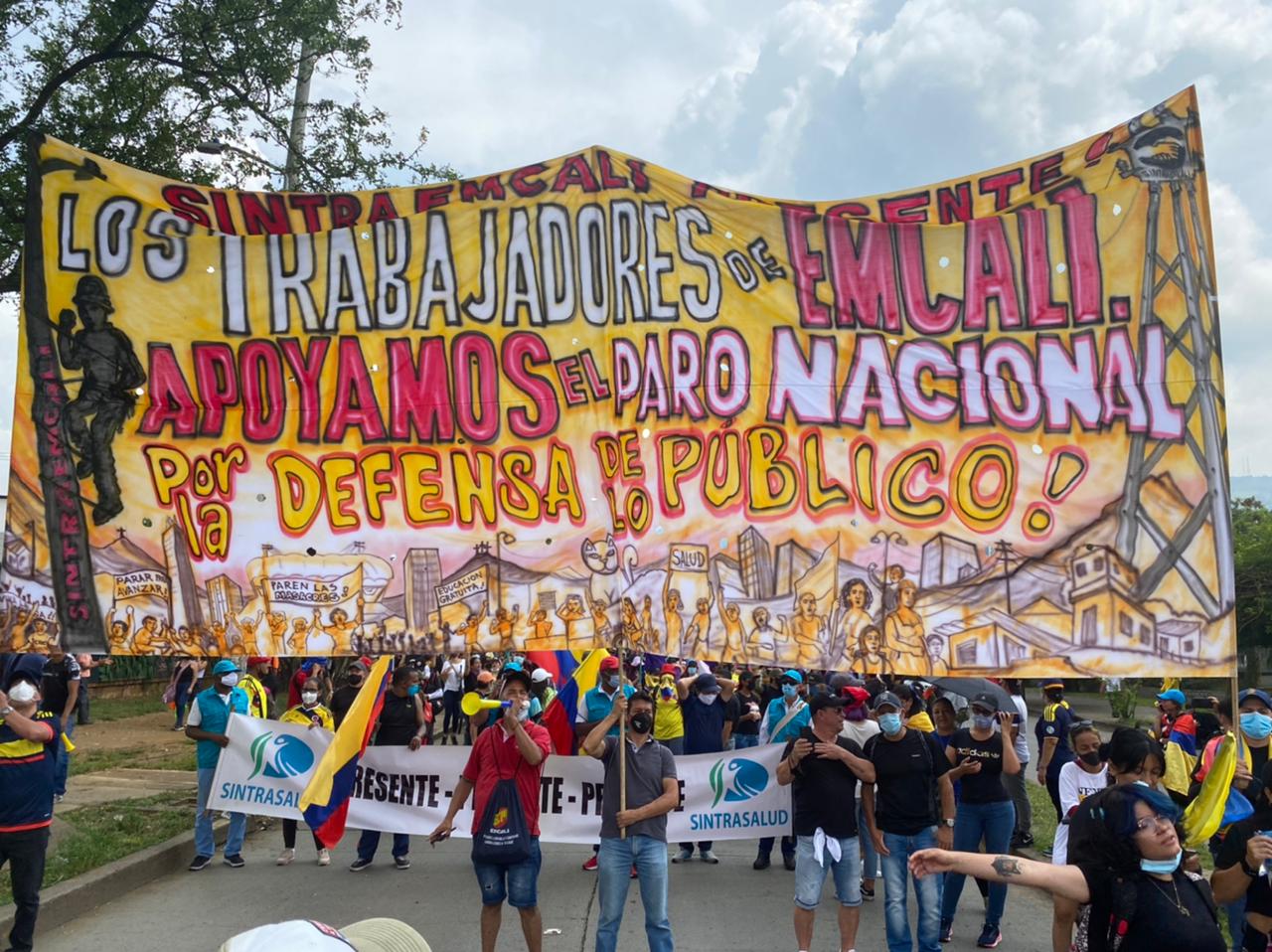Cali, Colombia 1st June 2021
Across the country the marches were absolutely huge on Friday 28th May, marking one month anniversary of beginning of strike.
In Cali the marches were just unbelievable. There were three marches during the day; all of them were absolutely massive. We were on the one which went from Siloé to la Universidad del Valle. It was impossible to find the start and the end of the march, it was simply huge, and a really beautiful, joyful march.
Again, a massive mix of sectors, it was a very broad ranging demographic of people participating. A few days earlier the right wing in Cali had organised the ‘marcha del silencio’ against the strike. They were wearing white. On our parts of the city a lot of people were making the point that we will never be silenced, and that silence is complicity, so ours was the march of the non-silence. And that was really the main theme of the day. A noisy, colourful, joyful march, it was really uplifting to see how at this stage there was still so much popular support for the strike.

As we were on the march, we got word that there had been five attacks during the course of the day against the punto de concentración in the la Luna area.
But we hadn’t foreseen what was about to come. As we were on the march, we got word that there had been five attacks during the course of the day against the punto de concentración in the la Luna area. The final attack ended with a situation where a guy shot two and killed two of the protesters. Then the protestors managed to catch him, they realised that he was somebody who worked for the CTI, part of the state prosecutors’ office, so he was an agent of the state.He was subsequently lynched by the furious crowd. That incident was a really painful event, and as news spread people were really upset to hear what had happened. Even that awful incident was just the beginning of what was to come.
What happened next in the Ciudad Jardín area has been widely circulated in social media. Armed civilians and police with live firearms were filmed side by side shooting protestors. We ended up with fourteen deaths in the city by the end of Friday. It was horrific.
It’s really important that we highlight just how serious this tactic is, this trend of civilians organising themselves into local, city-level and barrio-level paramilitary groups. We’re only now just realising the extent to which that’s being done in Cali and also the level of participation that there’s been in collaboration with the police, not just at the actual moments when events occur but also there’s evidence coming out that police have been involved in setting up these groups as well.
One of the people who was out there shooting in this group on Friday was quite a well-known sort of businessman, and he was outed on social media, so he then put out a video trying to offer an excuse and supposedly apologising but actually ended up incriminating himself and admitting that yes we have set up a group, that “we are here to defend against the vandals”… So, an open acknowledgement that this paramilitary organisation at city level is going on, which is really concerning now and going beyond the strike.
President Duque turned up here on Friday evening and went straight to Ciudad Jardín to speak to people there which was taken as tacit approval of this paramilitarisation that we’re seeing. He declared an almost de facto estado de conmoción where [he] took measures that oblige the militarisation of cities and towns across the Southwest of Colombia, particularly in Valle del Cauca. Decree 575 includes the threat that if mayors and governors refuse to militarise their cities then they can be punished and could even be removed from their posts, hence passing over power in the cities to the military and ordering the complete militarisation and removal of blockages on roads.

As one helicopter passes by the protests and demonstration, Duque’s announcement of military intervention led to huge fear and tension in Cali and across the region.
Duque’s announcement led to huge fear and tension in Cali and across the region, and the dynamic of the protests since then has definitely been affected. Because a lot of the violence has focused on the night-time and they’ve been going out and openly shooting against people, so gradually the tendency has been a bit of a relaxing at some of the puntos. People started to go home during the night, and then they would come and find in the morning that the police had removed everything. So, there are some puntos that are still remaining strong and still blocking; there are others that are not blocking the road but people are turning up and meeting there and protesting on the side of the road, maybe blocking one side of the road, or blocking intermittently. And there’s others again where there’s very little happening currently where they effectively have been removed.
Every day now there’s shootings at one or more of the puntos that still remain. People in civilian clothing, whether undercover police officers or paramilitaries or whatever, turn up and shoot to kill, most nights mainly. Last night in the Paso del Aguante, two of the protestors were killed. The day before, one of the guys on the primera línea was shot while he was at his post on the edge of Puerto Resistencia. And that night there was another guy who turned up dead at Puerto Resistencia, it’s unclear the circumstances but potentially also linked to the strike.
There have been more and more horrific cases coming out. There was trouble in Siloé over Friday and Saturday (29 and 30 May). Daniel Esquivel Sánchez, a 16-year-old boy who had gone out to work and was passing when there was fighting between the police and protesters. He was seen to be taken by the police and badly beaten. He was taken into a police armoured van and subsequently his body turned up in the Dollar City shop which was looted and vandalised and set on fire. When the fire died down, Daniel’s body was found there. So, it’s being treated as a falso positivo where the police randomly picked up this kid who wasn’t even involved in the protests, killed him, and then subsequently put his body in the shop to make it seem like he had been there looting and he had got caught in the trouble.
It is believed that there is an irregular holding centre in Cali where 400 prisoners are being held, 400 arrested people are being detained, some of whom are related to the strike, some of whom aren’t related to the strike. The existence of this place is not acknowledged by the state. It seems that some of the missing people were being held there without anybody knowing where they were. And the state was then forced to recognise its existence, and human rights groups yesterday eventually able to gain access and get a list of people there. This is part of a chilling development.


